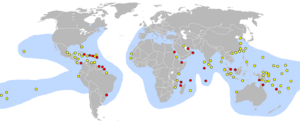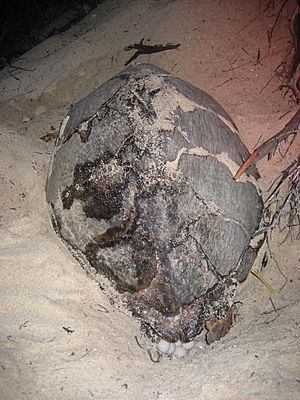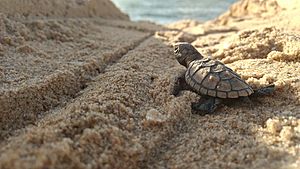Hawksbill sea turtle facts for kids
Quick facts for kids Hawksbill sea turtle |
|
|---|---|
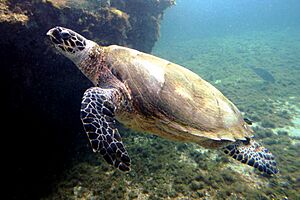 |
|
| Hawksbill sea turtle (Eretmochelys imbricata) | |
| Conservation status | |
| Scientific classification | |
| Genus: |
Eretmochelys
|
| Species: |
imbricata
|
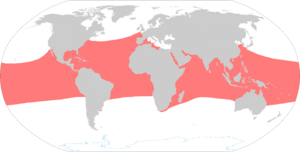 |
|
| Expert range map of the hawksbill sea turtle | |
| Synonyms | |
|
|
The hawksbill sea turtle (Eretmochelys imbricata) is a special type of sea turtle. It is critically endangered, which means it's at a very high risk of disappearing forever. It belongs to the Cheloniidae family. It's the only living species (type of animal) in its genus (a group of closely related species) called Eretmochelys. These turtles live all around the world, mostly in warm tropical and subtropical oceans and estuaries (where rivers meet the sea).
Hawksbill turtles look a bit like other sea turtles. They have a flat body, a hard shell called a carapace for protection, and flipper-like arms and legs made for swimming. What makes the hawksbill special is its sharp, curved beak, which looks like a hawk's beak. Also, the edges of its shell look like a saw. The color of their shells can even change a little depending on how warm the water is! Hawksbills spend some time in the deep ocean, but they prefer shallow lagoons and coral reefs.
Sadly, the World Conservation Union says hawksbills are critically endangered. This is mostly because of problems caused by human fishing. In the past, their beautiful shells were used to make things like jewelry and combs. This material was called tortoiseshell. Now, an international agreement called CITES helps protect them. It controls the trade of hawksbill turtles and products made from them.
Contents
How Scientists Named the Hawksbill Turtle
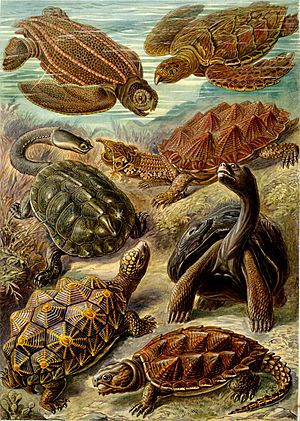
A famous scientist named Linnaeus first named the hawksbill sea turtle Testudo imbricata in 1766. Later, in 1843, another scientist, Leopold Fitzinger, moved it to a new group called Eretmochelys. For a short time in 1857, it was mistakenly called Eretmochelys imbricata squamata.
Scientists don't officially recognize different types (or subspecies) of hawksbills. They see them as one species that lives all over the world. Different groups live in various regions.
The name Eretmochelys comes from old Greek words. Eretmo means "oar" and chelys means "turtle." This refers to their oar-like front flippers. The species name imbricata is Latin and means "overlapping," like shingles on a roof. This describes how the plates (called scutes) on their shells overlap.
What Do Hawksbill Turtles Look Like?
Adult hawksbill turtles usually grow to about 1 m (3 ft) long. They weigh around 80 kg (180 lb). The heaviest one ever found weighed 127 kg (280 lb)! Their shell, or carapace, is usually amber-colored. It has a mix of light and dark streaks, mostly black and brown, spreading out to the sides.
Hawksbills have some unique features. Their head is long and pointy, ending in a beak-like mouth. This beak is sharper and more hooked than other sea turtles'. Their front flippers each have two claws.
One of the easiest ways to spot a hawksbill is by looking at the thick plates, called scutes, on its shell. Like other turtles in its family, it has five central scutes and four pairs of side scutes. But on a hawksbill, the scutes at the back overlap. This makes the edge of the shell look jagged, like a saw. Their shell can be almost 1 m (3 ft) long. Hawksbills often use their strong shells to squeeze into tight spots in coral reefs.
When hawksbills crawl on sand, they move their flippers one at a time. This leaves an uneven track. This is different from green sea turtles and leatherback turtles, which move their flippers more evenly.
Hawksbills are also biofluorescent, meaning they can glow under certain kinds of light! They were the first reptiles known to do this. Scientists aren't sure if it's because of what they eat, like certain glowing corals. Male hawksbills glow more brightly than females. Scientists think this might be important for how they behave.
Where Do Hawksbill Turtles Live?
Hawksbill sea turtles live in many parts of the world. They are mostly found in tropical coral reefs in the Indian, Pacific, and Atlantic Oceans. Out of all sea turtles, hawksbills are the ones most often found in warm tropical waters. There are two main groups, or subpopulations: one in the Atlantic and one in the Indo-Pacific (Indian and Pacific Oceans).
Atlantic Group
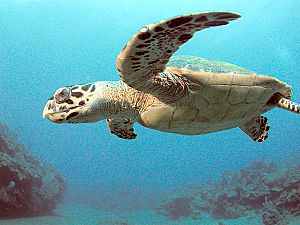
In the Atlantic Ocean, hawksbills can be found as far west as the Gulf of Mexico. They also live as far southeast as the tip of South Africa. They are also found off the coast of Brazil.
On the East Coast of the United States, they swim from Virginia down to Florida. In Florida, they mostly live on reefs in the Florida Keys and along the southeast Atlantic coast. Important nesting beaches are in Palm Beach, Broward, and Dade counties. A special program called THE FLORIDA HAWKSBILL PROJECT studies and protects these turtles and their homes. This project has found that hawksbills love coral reefs because they like to eat sponges and corals found there.
In the Caribbean, major nesting beaches are in places like the Lesser Antilles, Barbados, Guadeloupe, Tortuguero in Costa Rica, and the Yucatan. They also find food in the waters around Cuba and Mona Island near Puerto Rico.
Indo-Pacific Group
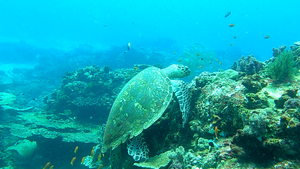
In the Indian Ocean, you can often see hawksbills along Africa's east coast. They are found around Madagascar and Mozambique. They are also common along the southern coast of Asia, including the Persian Gulf, the Red Sea, and near India and Southeast Asia. They live throughout the Malay Archipelago (islands between Southeast Asia and Australia) and northern Australia. In the Pacific, they stick to the warmer tropical and subtropical areas.
The Philippines has several nesting sites, like Boracay island and Punta Dumalag in Davao City. Dahican Beach in Mati City is an important hatchery for hawksbills and olive ridley sea turtles. A group of islands in the southwest Philippines is even called the "Turtle Islands" because hawksbills and green sea turtles nest there. In Singapore, hawksbills are making a comeback, nesting in places like East Coast Park. In Hawaii, they mostly nest on the main islands. In Australia, they nest on islands like Milman Island in the Great Barrier Reef. In the Seychelles islands, hawksbills have been protected by law since 1994. Their numbers are slowly increasing there.
Eastern Pacific Group
In the eastern Pacific Ocean, hawksbills are found from the Baja Peninsula in Mexico down to southern Peru. For a while, scientists thought they were almost gone from this area. But recently, important nesting and feeding spots have been found in Mexico, El Salvador, Nicaragua, and Ecuador. Unlike in other parts of the world where they love coral reefs, eastern Pacific hawksbills often live and nest in mangrove estuaries (swampy areas where rivers meet the sea). Groups like the Eastern Pacific Hawksbill Initiative are working to study and protect these turtles.
Hawksbill Turtle Habitat

Adult hawksbill turtles mostly live in tropical coral reefs. During the day, you can often find them resting in caves and under ledges in these reefs. They are migratory, meaning they travel long distances. So they live in different places, from the open ocean to lagoons and even mangrove swamps. Scientists don't know as much about where baby hawksbills live. Like other young sea turtles, they probably float around in the open sea until they get older. They are good at finding places to hide from predators.
What Do Hawksbill Turtles Eat?
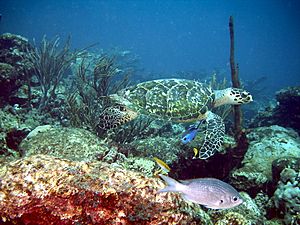
Hawksbills are omnivores, meaning they eat both plants and animals. But their main food is sea sponges – these make up 70–95% of their diet! They are picky eaters, though, and only eat certain types of sponges. Besides sponges, hawksbills also eat algae, seagrasses, jellyfish, corals, sea anemones, squid, snails, sea urchins, crabs, and even fish eggs. They can also eat the Portuguese man o' war, a dangerous jellyfish-like creature. Hawksbills close their eyes when they eat these stinging animals, as their armored heads protect them from the stings.
Hawksbills are tough and can eat things that would be harmful to other animals. Some sponges they eat are very toxic (poisonous). They also eat sponges that have lots of tiny, sharp, glass-like structures called spicules.
Hawksbill Turtle Life Cycle
Scientists are still learning about the lives of hawksbills. Their life can be split into three main parts:
- Early life: When they are small, from about 4 to 30 cm long.
- Growing up: When young turtles find feeding areas, often near the coast.
- Adult life: When they are old enough to reproduce and travel to breeding areas.
The early part of their life isn't as well understood as for other sea turtles. They might spend this time (from 0-4 years old) in the open ocean or closer to shore. One study found that hawksbills in the Pacific Ocean might be ready to have babies when they are about 72 cm long and around 29 years old (though it can range from 23 to 36 years). Once they find a good feeding spot, they tend to stay there. However, they can move to other similar places.
Hawksbill Turtle Reproduction
Hawksbills mate about every two years in quiet lagoons near their nesting beaches on remote islands. The most important nesting beaches are in places like Mexico, the Seychelles, Indonesia, Sri Lanka, and Australia. In the Atlantic, they usually mate between April and November. In the Indian Ocean, like in the Seychelles, they mate from September to February.
After mating, the female turtle drags herself up the beach at night. She clears away plants and sand, digs a hole with her back flippers, and lays a clutch (group) of eggs. Nests in the Caribbean and Florida usually have about 140 eggs. The eggs hatch after about 60 days. After laying her eggs and covering them with sand, which takes hours, the female goes back to the sea. Hawksbill nests are found on beaches in about 60 countries.
Baby turtles, called hatchlings, usually weigh less than 24 g (0.85 oz). They hatch at night after about two months. These new babies are dark-colored, with heart-shaped shells about 2.5 cm (0.98 in) long. They automatically crawl towards the sea, guided by the moon's reflection on the water. Streetlights and other lights can confuse them. If they don't reach the water by morning, they can be eaten by shorebirds, crabs, and other predators.
Adult Life of Hawksbill Turtles
Hawksbills seem to become adults after about 20 years. Scientists don't know exactly how long they live. Like other sea turtles, hawksbills are usually alone for most of their lives. They only meet up to mate. They travel long distances. Because their shells are so tough, adult hawksbills don't have many predators besides humans, sharks, crocodiles, octopuses, and some large fish.
Many things can affect when a turtle is ready to have babies. These include their genes, how much and what kind of food they eat, and how many other turtles are around. It's thought that Caribbean hawksbills mature between 10 and 25 years old. Turtles in the Indo-Pacific might take at least 30 to 35 years.
Hawksbill Turtles and Humans
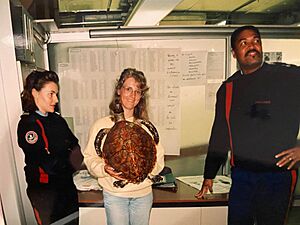
For a long time, people all over the world hunted hawksbill turtles. Today, it's illegal to catch, kill, or trade hawksbills in many countries. In some places, people still use hawksbill turtles and their eggs for food. As far back as the fifth century BCE, people in China ate sea turtles, including hawksbills.
Besides food, people also used their beautiful shells, known as tortoiseshell, turtle shell, or bekko. In China, the hawksbill is called dai mei or dai mao ("tortoise-shell turtle"). Its shell was used to make and decorate small items, just like in Western countries. In Japan, the turtles were hunted for their shell plates, called bekko. Bekko was used for things like eyeglass frames and picks for a Japanese instrument called a shamisen. In 1994, Japan stopped bringing in hawksbill shells from other countries. Before that, Japan used about 30,000 kg (66,000 lb) of raw shells each year. In Europe, ancient Greeks and Romans used hawksbill shells for jewelry like combs, brushes, and rings.
Scientists have studied how many hawksbills were hunted in the past. One study estimated that from 1950 to 1992, about 1.37 million adult hawksbills were killed just for the international tortoiseshell trade. A more recent study estimated that about 8.98 million hawksbills were killed for their shells between 1844 and 1992. Most of this happened in the Pacific Ocean.
Protecting Hawksbill Turtles
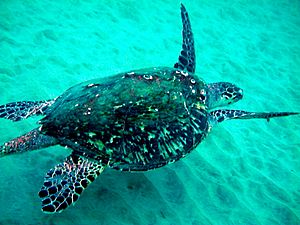
Scientists agree that sea turtles, including hawksbills, are in danger. This is because they grow slowly, take a long time to become adults, and don't have many babies at once. Humans have harmed many adult turtles, sometimes by accident and sometimes on purpose. Pollution and the loss of their nesting beaches due to building along coasts also threaten them. Biologists think the hawksbill population has dropped by 80 percent in the last 100–135 years. Animals like mongooses also dig up their eggs to eat.
In 1982, the IUCN Red List (a list of animals in danger) first said E. imbricata was endangered. This status stayed the same until 1996, when it was changed to critically endangered, which is even more serious. Experts showed that the worldwide hawksbill population had dropped by 80% in the last three generations (a generation for a turtle is a long time!).
The hawksbill turtle (and its whole family) is listed in Appendix I of CITES. This means that trading them internationally for business is banned. Other international trade (like for science) is strictly controlled.
The United States Fish and Wildlife Service and National Marine Fisheries Service have called hawksbills endangered since 1970. The U.S. government has plans to help protect them.
The Zoological Society of London has listed the hawksbill as an EDGE species. This means it's endangered and also very unique genetically. So it's especially important to protect.
The World Wildlife Fund Australia (WWF-Australia) has projects to help protect these turtles.
On Rosemary Island in Western Australia, volunteers have been watching hawksbill turtles since 1986. In November 2020, a turtle that was about 60 years old returned to the same spot! It had first been tagged in 1990 and again in 2011.
See also
 In Spanish: Tortuga carey para niños
In Spanish: Tortuga carey para niños






